Amti recipe with step by step photos. A Maharashtrian amti dal recipe is a comfort food for us any day. As much as I like having amti dal with rice, I also like sipping it. In fact dal as such is a comfort food.
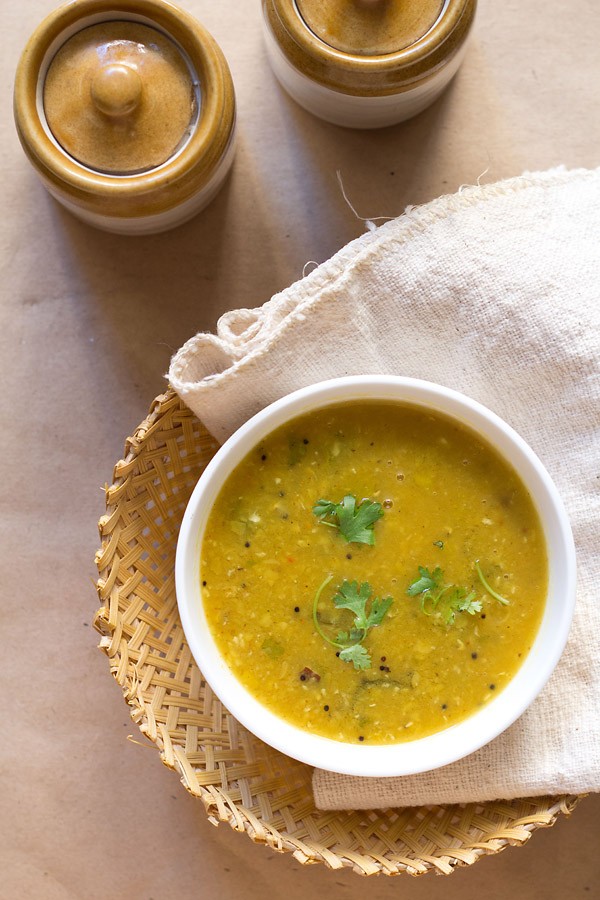
I make amti on those days when I have goda masala/kala masala in the kitchen. I had made a small batch of goda masala for making vangi bath (spiced brinjal rice).
I suggest to use goda masala while making amti. if you use any other masala like garam masala then you won’t get the same results. The reason being garam masala has a different spice blend and goda masala has an altogether different one.
There are some spices like Dagad phool or kalpasi (stone flower), sesame seeds, dry red chilies & desiccated coconut which are not there in garam masala.
This suggestion comes from someone who has made amti with garam masala. It tastes nice, but then it does not taste like amti, but just like a dal to which some coconut, jaggery, tamarind or kokum are added.
This amti recipe is slightly spiced and has both mild sour and sweet tones. The mild sour tones comes from tamarind or kokum and the light sweetness coming from jaggery.
Also the taste of the toor dal/pigeon pea lentils blends very well with the rest of the ingredients. in the absence of tamarind or kokum, you can use lemon juice.
This is also a no onion no garlic dal recipe. I also make another variation sans onion and garlic and having a sweet and sour taste are, the Gujarati Dal.
Fresh coconut is also added to amti. Its not essential, but a dash of fresh coconut brings a lot of flavor and taste to any dish. But at times when there is no coconut, I make the amti without coconut.
You can serve amti dal with rice or roti.
How to make Amti Recipe
Cook Lentils
1. Pick and rinse ½ cup of tuvar dal (arhar dal or pigeon pea lentils) very well in water. Then add the dal in the pressure cooker along with 1.5 to 2 cups of water and a pinch of turmeric.
If using a 2-litre pressure cooker, add 1.5 to 1.75 cups water. For a 3-litre pressure cooker add 2 cups water.
For best taste and flavor, try to make the amti recipe with unpolished tuvar dal.

2. Pressure cook the dal on medium to high heat for 7 to 8 whistles or till the dal is cooked completely and is of a mashable consistency.
When the pressure in the cooker settles down on its own, open the lid and mash the dal with a spoon or a wired whisk. Keep aside.
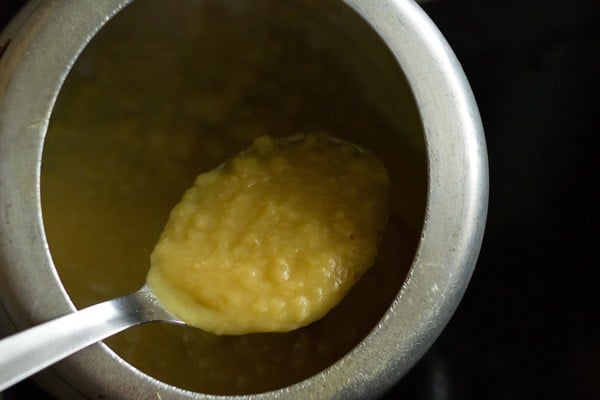
Make Amti Dal
3. In another pan, heat 1.5 to 2 tablespoons oil or ghee. Lower the heat and first crackle ½ teaspoon mustard seeds.
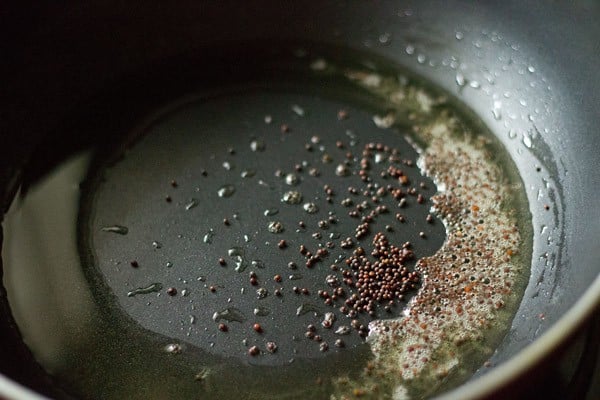
4. Then add ¼ teaspoon turmeric powder and a pinch of asafoetida (hing).
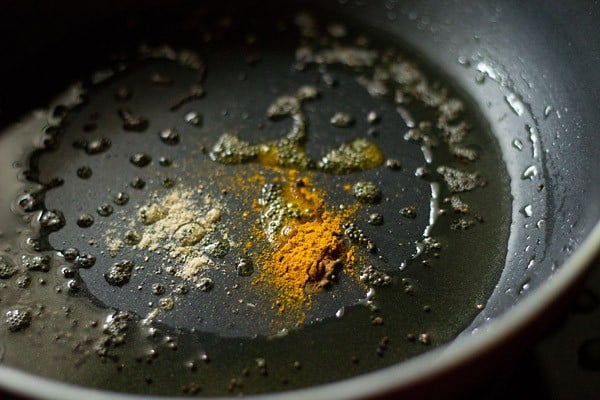
5. Stir and then add 7 to 9 curry leaves, 1 or 2 green chillies (chopped). Instead of green chillies you can also add ¼ to ½ teaspoon red chilli powder.

6. Add the mashed dal and stir.
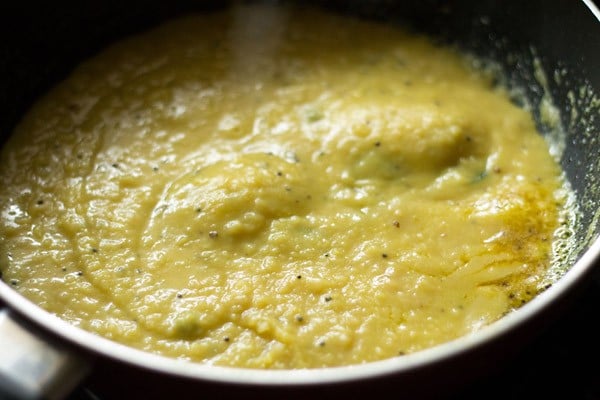
7. Add ½ to 1 cup water or as required to get a medium consistency in the dal. Stir very well.

8. Season with the following listed ingredients:
- 1.5 to 2 teaspoons of Goda Masala
- ½ tablespoon powdered jaggery or as needed
- 2 dried kokum or add according to taste
- 1 to 1.5 tablespoon grated coconut (optional)
- ½ tbsp chopped coriander leaves (optional)
- salt as required
Note that instead of kokum, you can also add tamarind pulp. For the tamarind pulp, before you start cooking the dal, heat 2 tablespoons water and add 1 teaspoon tightly packed seedless tamarind to it.
Soak for about 20 minutes. Squeeze the tamarind pulp from the soaked tamarind and keep aside. Add it at this step.
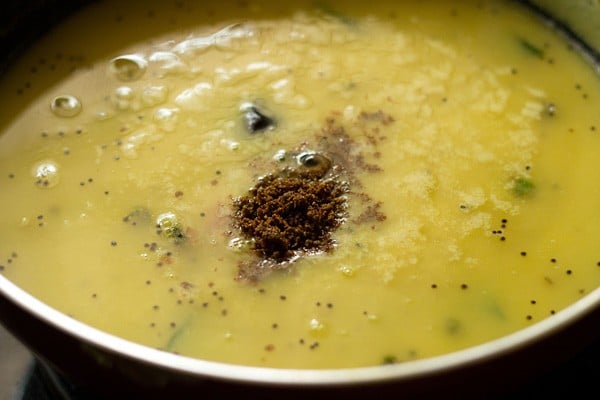
9. Simmer for 10 to 12 minutes on a low heat with frequent stirrings (so that the dal does not stick to the bottom of the pan) till the desired consistency is reached.
Lastly check the taste of amti and add more salt, jaggery or goda masala if needed.

10. While serving the amti dal, you can garnish with few coriander leaves if you prefer. Serve the amti with steamed rice or roti, topped with a little ghee.
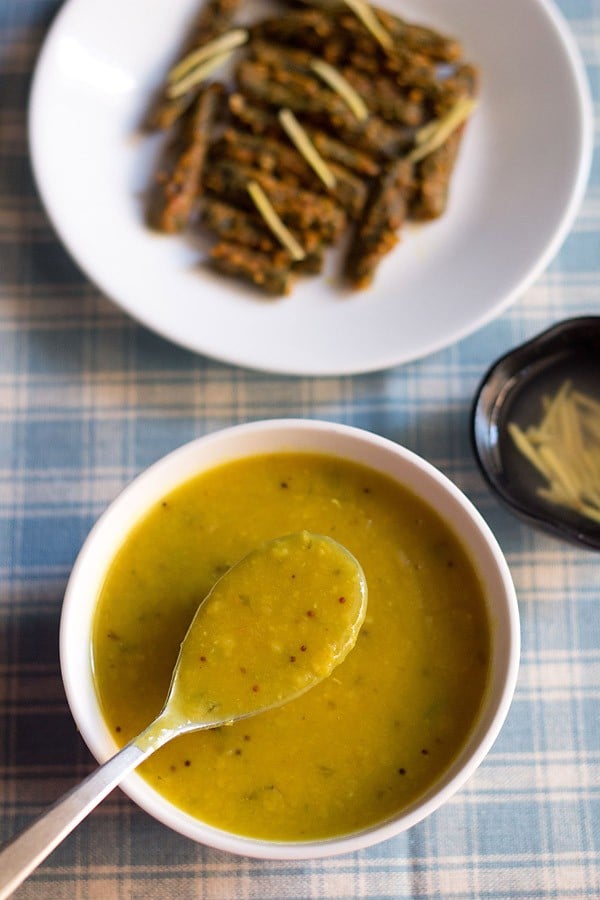
Few more Maharashtrian lentil recipes you may like are:
- Katachi Amti – Thin spicy dal made from the strained stock of cooked chana dal (bengal gram).
- Varan recipe – Delicious lentil stew or dal made with toor dal (pigeon pea lentils) and served with rice.
- Matki amti – Spiced and tasty Maharashtrian curry made with matki sprouts a.k.a moth bean sprouts.
Please be sure to rate the recipe in the recipe card or leave a comment below if you have made it. For more vegetarian inspirations, Sign Up for my emails or follow me on Instagram, Youtube, Facebook, Pinterest or Twitter.

Amti Recipe | Amti Dal
Ingredients
For cooking the dal
- ½ cup tuvar dal (toor dal or arhar dal or pigeon pea lentils)
- 1 pinch turmeric powder
- 1.5 to 2 cups water – for pressure cooking
Other ingredients for amti recipe
- 2 kokums or 1 teaspoon seedless tamarind tightly packed soaked in 2 tablespoons of hot water
- 1.5 to 2 teaspoons Goda Masala or kala masala
- ½ tablespoon powdered jaggery (gur) or as required
- ½ tablespoon coriander leaves (chopped)
- ½ to 1 cup water to be added later or add as required
- 1 to 1.5 tablespoon grated coconut – optional
- salt as required
for tempering amti dal
- ½ teaspoon mustard seeds
- 7 to 9 curry leaves
- 1 to 2 green chillies or ¼ to ½ teaspoon red chilli powder
- ¼ teaspoon turmeric powder
- 1 pinch asafoetida (hing)
- 1.5 to 2 tablespoons oil or ghee
for garnish
- 1 to 2 tablespoons coriander leaves (chopped)
Instructions
cooking toor dal
- Pick and rinse the dal first very well in water. Then add the dal in the pressure cooker along with 1.5 to 2 cups of water and a pinch of turmeric.
- Pressure cook the dal on medium to high flame for 7 to 8 whistles or till the dal is cooked completely and is of mashable consistency.
- When the pressure in the cooker settles down on its own, open the lid and mash the dal with a spoon or a masher. Keep aside.
making amti dal
- In another pan, heat 1.5 tbsp oil or ghee. First crackle the mustard seeds.
- Then add the turmeric powder and asafoetida.
- Stir and then add curry leaves, green chilies or red chili powder.
- Add the dal and stir.
- Add 1 cup water or as required to get a medium consistency in the dal. Stir very well.
- Season with 1.5 to 2 goda masala, ½ tbsp powdered jaggery, 2 kokums, 1 to 1.5 tbsp grated coconut (optional), ½ tbsp chopped coriander leaves (optional) and salt.
- Instead of kokums, you can also add tamarind pulp. For the tamarind pulp, before you start cooking the dal, heat 2 tbsp water and add tamarind to it. Soak for about 20 minutes. Squeeze the tamarind pulp from the soaked tamarind and keep aside. Add it at this step.
- Simmer for 10-12 minutes on a low heat with frequent stirring (so that the dal does not stick to the bottom of the cooker) till the desired consistency is reached.
- Lastly check the taste of amti and add more salt, jaggery or goda masala if required.
- While serving the amti, you can garnish with few coriander leaves if you prefer. Serve the amti dal with steamed rice topped with a little ghee.
Nutrition Info (Approximate Values)
This Amti recipe post from the archives, first published in February 2014 has been updated and republished on November 2022.








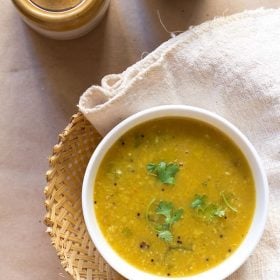
Hi Dassana
You have mentioned 1/2 cup daal in the list of ingredients whereas 1 cup daal in the recipe description with pictures. So wanted to confirm with you, for what quantity of daal are the various masala proportions in this recipe ?
thanks srushti for letting me know. it is half a cup dal and not 1 cup dal. that’s a typo i made. will update in the recipe.
Do you discard the water that you soak the dal in or cook in the same water? Why? I just can’t figure out the right way. My mom always cooked dal in the same water, but lots of blogs say discarding the water helps in removing “anti-nutrients.” I’m worried throwing out the water will also take away some of the nutrition. Which is the correct approach?
vrinda, i don’t soak dal when cooking. you don’t need to soak dal while cooking. when you soak beans then don’t use that water. because that water has phytates. that interferes with the digestion of nutrients.